|
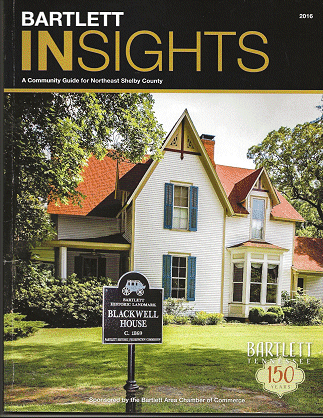
"Early Bartlett" by Jimmy Ogle, Shelby County Historian
(2016)
From the pages of Bartlett INSIGHT, published by the
Bartlett Chamber of Commerce in 2016
during the Celebration of the City of Bartlett's
Sesquicentennial at age 150.
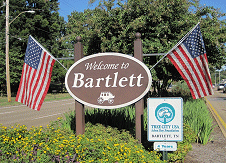 Early Paths, Roads &
Railroads. Early Paths, Roads &
Railroads.
 Centuries ago animal trails, which became worn down by
animals keeping their feet dry on a high ridge just
above a swollen Wolf River, then became the walk paths
used by nomadic Indians to cross the area from west to
east. These trails in Southwest Tennessee eventually
became paths and roads for European explorers and
American settlers. In the 19th century, the Old
Stage-Coach Road, now Stage Road (US Highway 64) was the
way across southern Tennessee from all points east in
Tennessee to Memphis and the Mississippi River for stage
coaches, overland mail, other travelers – even the Bell
Route of The Trail of Tears in the 1830s. As early as
1829, settlers were moving in to the area, the first
settlement was called Jessamine and future Bartlett
became the geographical center of Shelby County. Centuries ago animal trails, which became worn down by
animals keeping their feet dry on a high ridge just
above a swollen Wolf River, then became the walk paths
used by nomadic Indians to cross the area from west to
east. These trails in Southwest Tennessee eventually
became paths and roads for European explorers and
American settlers. In the 19th century, the Old
Stage-Coach Road, now Stage Road (US Highway 64) was the
way across southern Tennessee from all points east in
Tennessee to Memphis and the Mississippi River for stage
coaches, overland mail, other travelers – even the Bell
Route of The Trail of Tears in the 1830s. As early as
1829, settlers were moving in to the area, the first
settlement was called Jessamine and future Bartlett
became the geographical center of Shelby County.
Summer
Avenue
(US Highway 70, The Broadway of America), also known as
TN Highway 1 (The Bristol Highway) connected Memphis to
Nashville and further to the northeast corner of
Tennessee in the 20th century. Right smack dab in the
middle of all that is the place called “Four Way”, where
these two great routes intersect, as well as the City of
Bartlett.
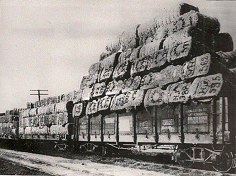 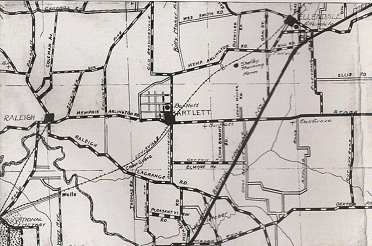 The Memphis & Ohio Railroad (later to become
the Louisville & Nashville Railroad, then CSX) began
laying tracks in 1852 and Union Depot (demolished in
1940) was an important stop, intersecting with Stage
Road. Originally called Bond Station, Ellendale became
the next railroad depot north of Bartlett Early Homes.
Three of the oldest homes in Bartlett are listed on the
National Register of Historic Places. The Manor House at
Davies Manor Plantation (listed in 1975), the oldest
residence in Shelby County, was begun in 1807 as a
single-room log cabin, and added onto throughout the
middle of the 19th century by Joel Royster, William
Davies and later Logan Davies growing the plantation to
almost 2,000 acres by the end of the century. The Memphis & Ohio Railroad (later to become
the Louisville & Nashville Railroad, then CSX) began
laying tracks in 1852 and Union Depot (demolished in
1940) was an important stop, intersecting with Stage
Road. Originally called Bond Station, Ellendale became
the next railroad depot north of Bartlett Early Homes.
Three of the oldest homes in Bartlett are listed on the
National Register of Historic Places. The Manor House at
Davies Manor Plantation (listed in 1975), the oldest
residence in Shelby County, was begun in 1807 as a
single-room log cabin, and added onto throughout the
middle of the 19th century by Joel Royster, William
Davies and later Logan Davies growing the plantation to
almost 2,000 acres by the end of the century.
 |
Davies Manor survived Union
occupation during the Civil War and
is open today as an historic
attraction portraying life in the
19th century. Cedar Hall (listed in
1994) on Broadway Road was built by
local physician Samuel Bond and
later occupied by Edmund Orgill
until the early 1900s. Cedar Hall,
listed as the John H. McFadden House
on the National Register, is nearly
7,000 square feet of Colonial
Revival elegance. Cedar Hall was a
private residence until 2007 and in
2012 became a bed and breakfast. The
Gotten House (listed in 2002) on
Court Street was built in 1871 by
German immigrant Nicholas Gotten,
the town’s first constable and also
a blacksmith and a ginner, who was
an innovator in ginning equipment.
Today it is the Bartlett Museum and
maintained by the Bartlett
Historical Society. |
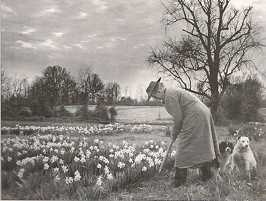 19th
Century.
Agriculture ruled the community in the 19th century, as
soybeans, cotton and flowers prevailed.
19th
Century.
Agriculture ruled the community in the 19th century, as
soybeans, cotton and flowers prevailed.
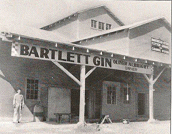 Kate Bond,
daughter of early settlers William and Hallie Bond, grew
fields of flowers for sale at the Memphis Curb Market
and provided flower arrangements to many local
hospitals. Many families grew fruits and vegetables,
including watermelons and strawberries for sale to
markets, restaurants and hotels in Memphis. Nicholas
Gotten opened a cotton gin that served over 10 square
miles surrounding the Bartlett area. He received a U.S.
patent in 1881 for an improvement to the cotton gin
feeder. Kate Bond,
daughter of early settlers William and Hallie Bond, grew
fields of flowers for sale at the Memphis Curb Market
and provided flower arrangements to many local
hospitals. Many families grew fruits and vegetables,
including watermelons and strawberries for sale to
markets, restaurants and hotels in Memphis. Nicholas
Gotten opened a cotton gin that served over 10 square
miles surrounding the Bartlett area. He received a U.S.
patent in 1881 for an improvement to the cotton gin
feeder.
Early
Settlers.
At the close of the Revolutionary War, North Carolina’s
boundaries reached to the Mississippi River (until 1796)
and many veterans received land grants in this area. The
three largest land grants in the area were later bought
by George Doherty, William Polk and Richard Smith, who
then subdivided their lands for sale to other settlers. The most recognized names in Bartlett today are from the
early settlers and farmers. Cousins John Blackwell (Goodwood)
and Gabriel Bartlett (Green Bottom) settled in the area
in the 1840s, and became large land owners and cotton
farmers. Dr. Nicholas Blackwell moved to Bartlett after
the Civil War and became a leading citizen, land
developer and physician in the area, and the town’s
second Mayor. Other early prominent citizens were Joseph
Cotton, John Lilly (carriage maker), Billy Maher, James
Oglesby (carpenter), H. L. Priddy (general store), James
Pruden, Harvey Williams (farmer), Joseph Ward, and W. B.
Wright (postmaster).
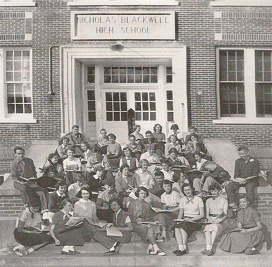 Early
Schools, Churches & Cemeteries.
The vacated Circuit Court building was used as a school
(Bartlett Courthouse School) for 32 years. Bartlett High
School was built in 1917 on land donated by Nicholas’
daughter, Willie Blackwell Miller, in memory of her
father, Dr. Nicholas Blackwell. Miss Dora Gholson was
the first principal for over one hundred students and
seven faculty members. In 1866, Gabriel Bartlett donated
land for the first Freedman school in the area, which
was the first school for black students. The Shelby
County Industrial& Training School (1905-1935) provided
a school and work farm for boys from destitute families.
Thomas Westendorf, who became the school’s
superintendent in 1907. Horse-drawn wagonettes for
students were introduced in 1908 and replaced by
motorized buses in the 1920s.
Early
Schools, Churches & Cemeteries.
The vacated Circuit Court building was used as a school
(Bartlett Courthouse School) for 32 years. Bartlett High
School was built in 1917 on land donated by Nicholas’
daughter, Willie Blackwell Miller, in memory of her
father, Dr. Nicholas Blackwell. Miss Dora Gholson was
the first principal for over one hundred students and
seven faculty members. In 1866, Gabriel Bartlett donated
land for the first Freedman school in the area, which
was the first school for black students. The Shelby
County Industrial& Training School (1905-1935) provided
a school and work farm for boys from destitute families.
Thomas Westendorf, who became the school’s
superintendent in 1907. Horse-drawn wagonettes for
students were introduced in 1908 and replaced by
motorized buses in the 1920s.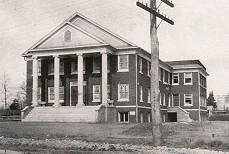 Bartlett Baptist Church
was organized in 1849 and previously known as Prosperity
Baptist Church. A Methodist congregation, Warren Chapel,
was organized in 1837. Black First Baptist Church,
formerly known as Bethlehem Baptist Church was formed in
1865. A Presbyterian church was built in 1866. Fullview
Baptist Church was established in 1877. Pisgah Cemetery,
now known as Bartlett-Ellendale Cemetery, is the final
resting place for many early settlers of the area, with
the earliest known burial being Sarah C. Bond in 1837.
The Tollgate Cemetery was established in 1846, deriving
its name from the tollgate on the Memphis-to-Somerville
plank road. Bartlett Baptist Church
was organized in 1849 and previously known as Prosperity
Baptist Church. A Methodist congregation, Warren Chapel,
was organized in 1837. Black First Baptist Church,
formerly known as Bethlehem Baptist Church was formed in
1865. A Presbyterian church was built in 1866. Fullview
Baptist Church was established in 1877. Pisgah Cemetery,
now known as Bartlett-Ellendale Cemetery, is the final
resting place for many early settlers of the area, with
the earliest known burial being Sarah C. Bond in 1837.
The Tollgate Cemetery was established in 1846, deriving
its name from the tollgate on the Memphis-to-Somerville
plank road.
The Civil
War & Yellow Fever.
Major land battles of the Civil War missed the Bartlett
area, with the closest skirmish coming in 1862 at
Morning Sun, east of the area, south of the Old
Stagecoach Road. Union General Lew Wallace’s
headquarters were in Union Depot (future Bartlett) to
protect the railroad tracks.
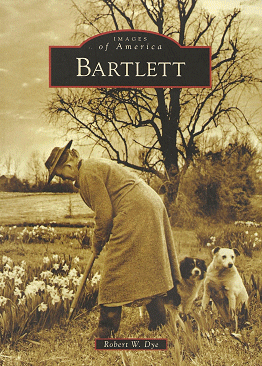 Nicholas Gotten served
under Confederate General Nathan Bedford Forrest as a
cavalryman and blacksmith. Members of the Blackwell
family served in the New Albany Grays of the
Confederacy, as did Col. Clark Barteau. As the Yellow
Fever epidemic spread through the county in the 1870s,
the Courthouse was used as a hospital. Nicholas Gotten served
under Confederate General Nathan Bedford Forrest as a
cavalryman and blacksmith. Members of the Blackwell
family served in the New Albany Grays of the
Confederacy, as did Col. Clark Barteau. As the Yellow
Fever epidemic spread through the county in the 1870s,
the Courthouse was used as a hospital.
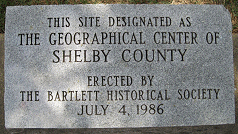 Incorporation.
Previous known as Union Depot (an unpopular name after
the Civil War) and/or Green Bottom, the town of Bartlett
was incorporated in 1866 with less than one hundred
citizens and named for Major Gabriel M. Bartlett, a
leading area resident. On April 14, 1866, the Daily
Memphis Argus wrote: “Bartlett is pleasantly and
beautifully situated on the rise of the Memphis and Ohio
Railroad”. Gabriel Bartlett was also elected the first
Mayor of Bartlett in 1867. From 1870-1885, Circuit
Courts met in Bartlett. When the courts closed in 1885,
Bartlett citizens also voted to dissolve the city
charter to reduce the saloons and alcohol consumption,
as an unincorporated city was forbidden from selling
alcohol. With the loss of the Circuit Courts, there was
a loss of population and it was not until 1905 that
Bartlett was able to regain its charter! For its first
100 years, Bartlett’s population did not rise above 600
residents! The first newspaper, the Bartlett News, was
published in 1875.
Incorporation.
Previous known as Union Depot (an unpopular name after
the Civil War) and/or Green Bottom, the town of Bartlett
was incorporated in 1866 with less than one hundred
citizens and named for Major Gabriel M. Bartlett, a
leading area resident. On April 14, 1866, the Daily
Memphis Argus wrote: “Bartlett is pleasantly and
beautifully situated on the rise of the Memphis and Ohio
Railroad”. Gabriel Bartlett was also elected the first
Mayor of Bartlett in 1867. From 1870-1885, Circuit
Courts met in Bartlett. When the courts closed in 1885,
Bartlett citizens also voted to dissolve the city
charter to reduce the saloons and alcohol consumption,
as an unincorporated city was forbidden from selling
alcohol. With the loss of the Circuit Courts, there was
a loss of population and it was not until 1905 that
Bartlett was able to regain its charter! For its first
100 years, Bartlett’s population did not rise above 600
residents! The first newspaper, the Bartlett News, was
published in 1875.
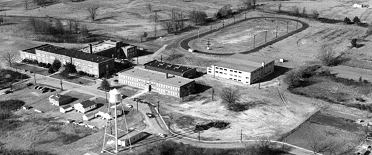 20th
Century – The First 50 Years.
During the first fifty years of the 20th century, the
business district suffered three disastrous fires, the
last being in 1924. Bartlett continued as a cotton
center until the boll weevil became a determined enemy
along with some over farming of the land.
20th
Century – The First 50 Years.
During the first fifty years of the 20th century, the
business district suffered three disastrous fires, the
last being in 1924. Bartlett continued as a cotton
center until the boll weevil became a determined enemy
along with some over farming of the land.
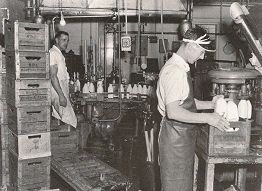 So, after
World War I, Bartlett became a dairy town and had as
many as twenty dairies – Albright, Cedar Hill, Clifton,
Crenshaw, Haefker, Klinke, Norwood, Reid and Tate were
names of some of the dairy operations. Elva Talbot
Bledsoe, longtime “unofficial” Bartlett Historian , was
the founder of the Bartlett Historical Society in 1982
and negotiated with the City of Bartlett to preserve the
Gotten House, now the site of the Bartlett Museum. Civic
organizations such as the Future Farmers of America,
Bartlett Garden Club and the Lions Club thrived in the
middle of the 20th century. Ellen Davies-Rodgers became
Shelby County’s first official Historian and she also
designed the flag for Shelby County. Some leading
citizens who contributed to Bartlett in this era were
Robert Dye (photography), W. J. Freeman (alderman), John
George (high school principal), Clarence Gowen (mayor
and historian) and Oliver Albright (gin owner). So, after
World War I, Bartlett became a dairy town and had as
many as twenty dairies – Albright, Cedar Hill, Clifton,
Crenshaw, Haefker, Klinke, Norwood, Reid and Tate were
names of some of the dairy operations. Elva Talbot
Bledsoe, longtime “unofficial” Bartlett Historian , was
the founder of the Bartlett Historical Society in 1982
and negotiated with the City of Bartlett to preserve the
Gotten House, now the site of the Bartlett Museum. Civic
organizations such as the Future Farmers of America,
Bartlett Garden Club and the Lions Club thrived in the
middle of the 20th century. Ellen Davies-Rodgers became
Shelby County’s first official Historian and she also
designed the flag for Shelby County. Some leading
citizens who contributed to Bartlett in this era were
Robert Dye (photography), W. J. Freeman (alderman), John
George (high school principal), Clarence Gowen (mayor
and historian) and Oliver Albright (gin owner).
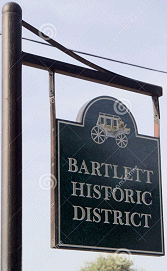 Did You
Know?
Union General Lew Wallace, whose Civil War headquarters
were in Bartlett, later wrote the epic Ben-Hur. Illinois
central railroad engineer Bartlett resident Avery G.
“Rabbit” Warner brought his train (and Engine # 382)
into Front Street Station in Memphis on April 29, 1900
about two hours late.
Did You
Know?
Union General Lew Wallace, whose Civil War headquarters
were in Bartlett, later wrote the epic Ben-Hur. Illinois
central railroad engineer Bartlett resident Avery G.
“Rabbit” Warner brought his train (and Engine # 382)
into Front Street Station in Memphis on April 29, 1900
about two hours late.
 The famous railroad engineer Casey
Jones replaced Warner on what became the most famous
train wreck in the nation’s history on April 30 in
Vaughn, Mississippi, when Jones was killed in a wreck
trying to make up for the lost time. School
Superintendent, Thomas Westendorf had previously gained
fame by writing the song “I’ll Take You Home Again,
Kathleen”, which was recorded by the likes of Bing
Crosby, Merv Griffin, Elvis Presley and Johnny Cash.
Clarence Saunders, founder of the first self-service
grocery store in America in 1916 (Piggly Wiggly,
Memphis) and builder of what eventually became the Pink
Palace Museum, died in his Bartlett home in 1953. The
residential area to the north of the business section of
Bartlett Station has recently been named a Historic
District. And, for some reason, it seems as though no
one in Union Depot or Green Bottom (or Bartlett) every
liked Davy Crockett! The famous railroad engineer Casey
Jones replaced Warner on what became the most famous
train wreck in the nation’s history on April 30 in
Vaughn, Mississippi, when Jones was killed in a wreck
trying to make up for the lost time. School
Superintendent, Thomas Westendorf had previously gained
fame by writing the song “I’ll Take You Home Again,
Kathleen”, which was recorded by the likes of Bing
Crosby, Merv Griffin, Elvis Presley and Johnny Cash.
Clarence Saunders, founder of the first self-service
grocery store in America in 1916 (Piggly Wiggly,
Memphis) and builder of what eventually became the Pink
Palace Museum, died in his Bartlett home in 1953. The
residential area to the north of the business section of
Bartlett Station has recently been named a Historic
District. And, for some reason, it seems as though no
one in Union Depot or Green Bottom (or Bartlett) every
liked Davy Crockett!
For current information about Bartlett, please
visit the official website:
https://www.cityofbartlett.org
Or, at Bartlett Area Chamber of Commerce:
www.bartlettchamber.org
901-372-9457
Or, at the Bartlett Historical Society:
In 1982, the Bartlett Historical Society was
chartered. The Society obtained permission from
the
City to refurbish the Gotten House as the home
of the Society and a museum, and it was leased
to the Society for fifty years. On October 17,
1990, the museum was formally dedicated to the
city.
https://www.facebook.com/Bartlett-Historical-Society-Bartlett-TN
Bartlett History Interactive Map
https://cityofbartlett.org/55/history
and /or on Facebook:
https://www.facebook.com/bartletttennessee
Bartlett by Robert W. Dye, Images Of America
Series

For limited information about
the Green Bottom
and Union Depot,
visit their listings
in the
Community Histories section.
|